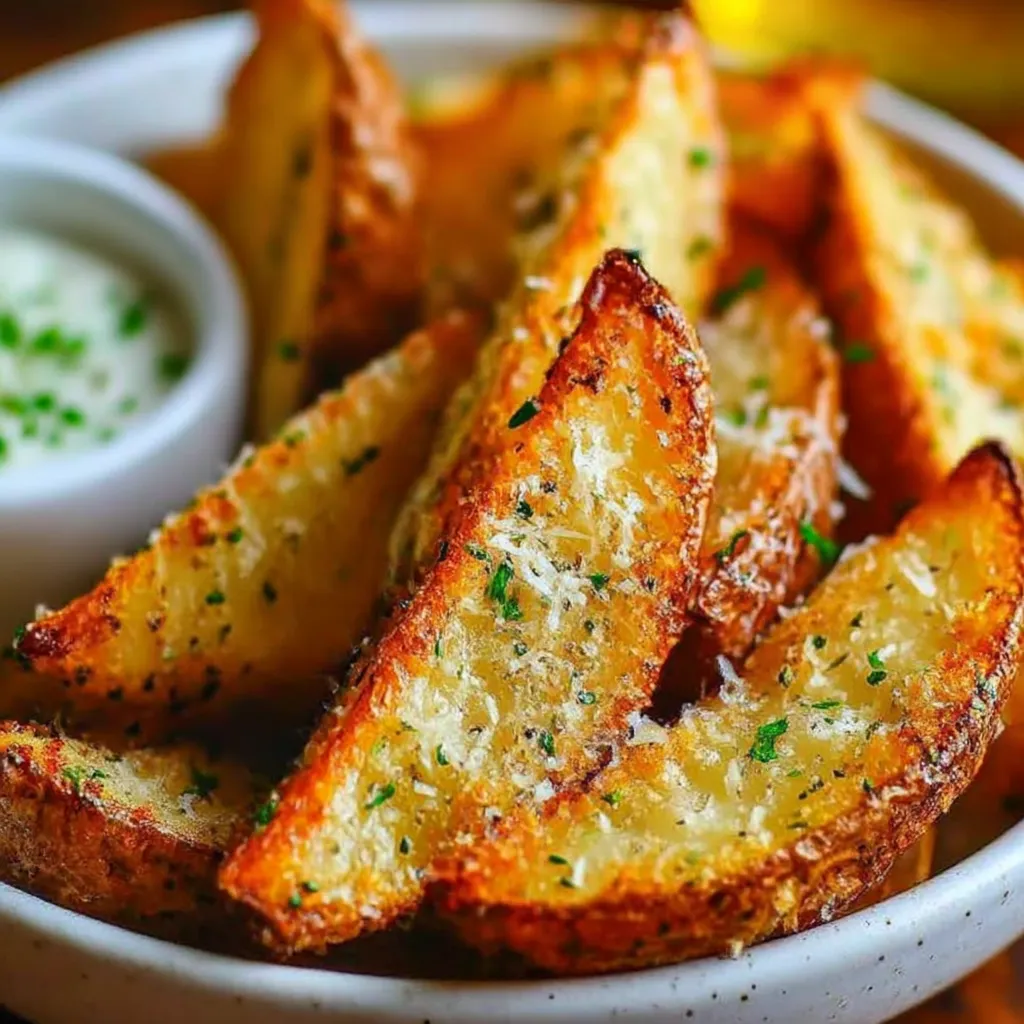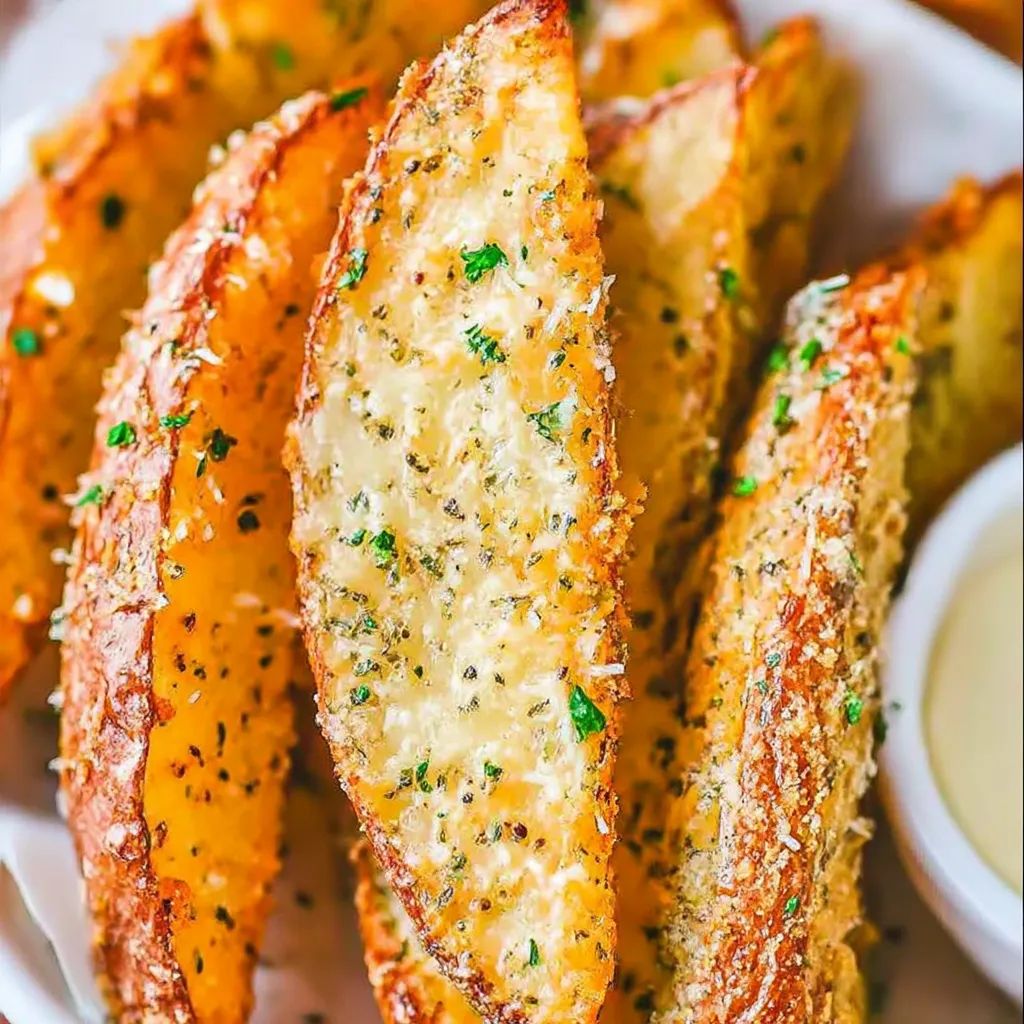 Save
Save
This baked garlic Parmesan potato wedge recipe transforms ordinary potatoes into crispy, flavorful delights that rival any restaurant offering. The combination of fresh Parmesan and aromatic seasonings creates a perfect balance that makes these wedges impossible to resist.
I first made these potato wedges when looking for a side dish that would please both my picky children and dinner guests. They've since become our go-to comfort food, requested at nearly every family gathering.
Ingredients
- Russet potatoes: their high starch content creates that perfect crispy exterior and fluffy interior. Choose large, firm potatoes without green spots or sprouts.
- Salt: enhances all the flavors and helps draw moisture out for extra crispiness. Kosher salt works best for even distribution.
- Garlic powder: provides consistent flavor throughout without burning like fresh garlic might. Look for fresh powder without clumps.
- Italian seasoning: adds herbaceous notes that complement the Parmesan perfectly. A blend with oregano, basil, and thyme works wonderfully.
- Olive oil: helps achieve golden crispiness and carries flavor. Extra virgin adds a subtle richness.
- Fresh Parmesan cheese: creates that irresistible savory crust. Grating your own rather than using pre-shredded makes a noticeable difference in melting quality.
Step-by-Step Instructions
- Prepare the potatoes:
- Thoroughly wash and dry your Russet potatoes before cutting. This removes excess starch and ensures crispier results. Cut each potato in half lengthwise, then slice each half into 3-4 wedges of equal size to ensure even cooking. The uniform size is crucial for all wedges to finish cooking at the same time.
- Season generously:
- Place potato wedges in a large bowl and drizzle with olive oil, using your hands to ensure each piece is completely coated. The oil acts as the glue for your seasonings and helps create that golden exterior. In a separate small bowl, mix salt, garlic powder, and Italian seasoning before sprinkling over the oiled potatoes. Toss again to distribute evenly, then add the freshly shredded Parmesan and toss once more until every wedge is coated with cheese.
- Arrange for optimal crispiness:
- Line your baking sheet with parchment paper to prevent sticking and make cleanup easier. Position each potato wedge skin side down with space between them. Overcrowding causes steaming rather than roasting, which prevents that desirable crispy texture. The skin side down position helps create a sturdy base that crisps beautifully.
- Bake to perfection:
- Place your baking sheet in a fully preheated 400°F oven. Baking at this temperature allows the wedges to develop a golden crust while keeping the centers tender. After about 15 minutes, carefully flip each wedge to ensure even browning. Total baking time ranges from 25 to 35 minutes depending on your oven and the size of your wedges. Look for a deep golden color and test tenderness with a fork.
 Save
Save
The Italian seasoning blend is my secret weapon in this recipe. My grandmother always added a pinch of rosemary to her potatoes, which inspired the herb blend here. Watching my children devour these nutritious wedges brings back warm memories of Sunday dinners at her table, where potatoes were always served crispy and golden.
Perfect Pairings
These wedges complement nearly any main dish but shine especially alongside grilled burgers, roasted chicken, or baked fish. For an elevated experience, serve them with a selection of dipping sauces like garlic aioli, sriracha mayo, or honey mustard. The contrast between the crispy, savory wedges and a creamy or tangy sauce creates a perfect balance of flavors and textures.
Storage and Reheating
Store any leftover potato wedges in an airtight container in the refrigerator for up to three days. To reheat, avoid the microwave which makes them soggy. Instead, place them on a baking sheet in a 375°F oven for 10 minutes until heated through and crispy again. You can also repurpose leftovers by chopping them into smaller pieces and adding them to breakfast hash or frittatas.
Customization Options
While this base recipe is wonderful, you can easily adapt it to your taste preferences. Try adding a teaspoon of smoked paprika for a subtle smoky flavor, substitute Romano cheese for a sharper taste, or sprinkle with red pepper flakes before baking for a spicy kick. For a loaded version, top the hot wedges with crumbled bacon, chives, and a dollop of sour cream just before serving.
Recipe FAQs
- → Can I use different types of potatoes for this dish?
Yes, while Russet potatoes are ideal for their starchy content and crispy exterior, you can substitute Yukon Gold for a buttery flavor or red potatoes for a waxier texture. Just adjust cooking times slightly as different varieties may cook faster or slower.
- → How do I ensure my potato wedges get crispy?
For maximum crispiness: thoroughly dry potatoes after washing, don't overcrowd the baking sheet, arrange them skin-side down, and make sure your oven is fully preheated to 400°F. Flipping halfway through cooking also helps achieve even browning.
- → Can I prepare these potato wedges ahead of time?
You can cut the potatoes and store them in cold water in the refrigerator for up to 24 hours. Just be sure to thoroughly dry them before adding oil and seasonings. For best results, season and bake just before serving.
- → What are the best dipping sauces to serve with these wedges?
These garlic Parmesan wedges pair wonderfully with aioli, ranch dressing, sriracha mayo, marinara sauce, or even a simple sour cream and chive dip. The notes also suggest bleu cheese, ketchup, queso, or honey mustard as excellent options.
- → How should I store and reheat leftovers?
Store cooled leftovers in an airtight container in the refrigerator for up to 3 days. For best results, reheat in an oven or toaster oven at 375°F for 5-10 minutes until hot and crispy again. Avoid microwaving as this can make them soggy.
- → Can I make these wedges without Parmesan cheese?
Absolutely! You can omit the Parmesan for a dairy-free version, or substitute nutritional yeast for a similar umami flavor. You might want to add a bit more salt and herbs to compensate for the missing cheese flavor.
